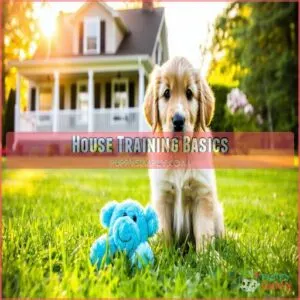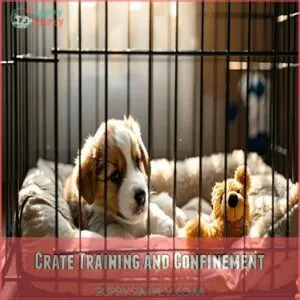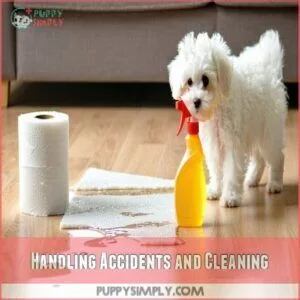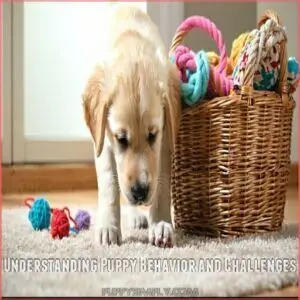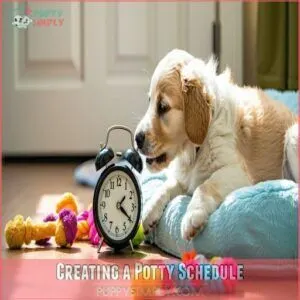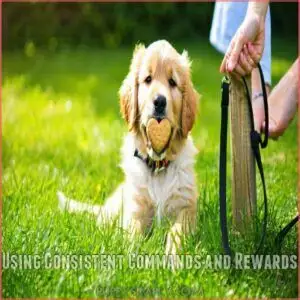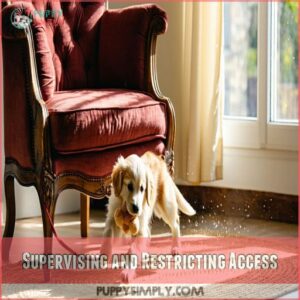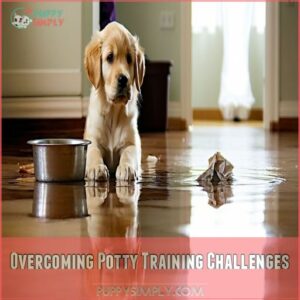This site is supported by our readers. We may earn a commission, at no cost to you, if you purchase through links.
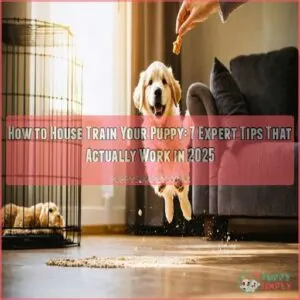 House training your puppy takes patience, consistency, and a little planning.
House training your puppy takes patience, consistency, and a little planning.
Start by setting a schedule—take your puppy outside every two hours, after meals, and first thing in the morning.
Pick a designated potty spot and stick to it; your puppy will catch on faster with consistency.
When they go outside, reward them immediately with treats and enthusiastic praise—puppies thrive on positive reinforcement!
Crate training can also help, as most puppies avoid soiling their sleeping area.
Accidents will happen, so stay calm, clean up thoroughly with an enzyme cleaner, and get back on track.
With time, your pup will master it!
Table Of Contents
- Key Takeaways
- House Training Basics
- How to House Train
- Creating a Potty Schedule
- Effective Potty Training Tips
- Overcoming Potty Training Challenges
- Frequently Asked Questions (FAQs)
- How do you train a dog to pee outside?
- How do you train a dog not to poop in the house?
- What is the fastest way to house train a puppy?
- How long does it take to housetrain a puppy?
- What is the 10 minute rule for potty training?
- At what age should a puppy be potty trained?
- How can I establish a potty training routine with a busy schedule?
- How long should I expect the potty training process to take?
- What can I do to help my puppy settle at night?
- How do I know if my puppy is having an accident due to medical issues?
- Conclusion
Key Takeaways
- You’ll need to establish a consistent routine and schedule for feeding and potty breaks, taking your puppy out every two hours, after meals, and upon waking.
- You should choose a designated potty spot outdoors and consistently take your puppy there to reinforce the behavior.
- You must use positive reinforcement, rewarding your puppy immediately with treats and praise for successful potty breaks.
- You should understand that accidents are normal and handle them calmly, using enzyme cleaners and avoiding punishment, and consider crate training as a helpful tool.
House Training Basics
You’ll find success in house training your puppy by following three key elements: a consistent schedule, a designated bathroom spot, and positive reinforcement.
Whether you’re dealing with an eight-week-old puppy or an adult rescue, these proven basics will help you establish good habits and prevent accidents in your home, using a consistent schedule.
Establishing a Routine and Schedule
Setting up a house training schedule is like mapping out your puppy’s day – it’s essential for success.
Your puppy needs consistent potty timing and feeding schedules to develop reliable elimination patterns. For effective puppy training, establishing a routine is key to preventing accidents and promoting successful eliminations.
- Take your pup out every 2 hours, plus after meals
- Maintain fixed feeding times (2-3 daily based on age)
- Remove water 2.5 hours before bedtime
- Schedule morning routines for immediate potty breaks
- Monitor bladder control (1 hour per month of age)
To ensure your puppy’s development is on track, remember that reliable elimination patterns and a routine are crucial. By following these guidelines, you can help prevent accidents and promote a healthy, happy puppy.
Choosing a Bathroom Spot
Successfully training your puppy starts with picking the perfect potty spot.
Choose a designated outdoor area that’s easily accessible year-round and stick to it.
Lead your pup on a leash to this spot each time – consistency is key for establishing their bathroom routine.
Your designated potty zone should be away from high-traffic areas but close enough for quick access during training.
Using a puppy training spot can help simplify the housebreaking process.
Positive Reinforcement and Rewards
Think of rewards as your puppy’s report card – they need clear feedback to understand what they’ve done right.
When your pup eliminates outside, immediately offer treats and enthusiastic praise. Don’t wait until you’re back inside, as this breaks the connection between the action and reward.
Consistent reinforcement helps your puppy understand that outdoor potty breaks equal positive outcomes.
Keep treats handy and your praise genuine.
How to House Train
You’ll find success in house training your puppy by combining proper crate training, consistent cleaning routines, and an understanding of your puppy’s natural behaviors.
With these proven methods and a bit of patience, you can transform your furry friend from a puddle-maker to a potty-training graduate in just a few weeks.
Crate Training and Confinement
Your puppy’s crate should be their cozy den – just big enough to stand, turn, and lie down.
For effective crate training puppy success, skip cushions until they’re fully potty trained. The right crate size prevents accidents while tapping into their natural denning instinct.
When you can’t watch them, the crate provides puppy security and prevents mishaps. Using potty training methods consistently is key to housebreaking success.
Remember, never use the crate as punishment.
Handling Accidents and Cleaning
Accidents happen during house training, but handling them right avoids setbacks.
Stay calm and act fast:
- Interrupt gently: Scoop your puppy mid-accident and head to their potty spot.
- Use enzyme cleaners: They eliminate odors, preventing repeat accidents.
- Ditch ammonia cleaners: These mimic urine smells.
- Restrict access: Limit roaming until house training sticks.
Using puppy pads can be an effective tool in the house training process.
Consistency keeps house training problems at bay!
Understanding Puppy Behavior and Challenges
Understanding puppy behavior is the secret sauce to smoother house training.
Puppies aren’t born knowing the rules—housebreaking struggles stem from natural behavioral patterns. Watch for signs like circling or sniffing that signal potty needs. Socialization shapes good habits, while patience handles accidents.
Effective puppy training at home requires a deep understanding of these patterns to establish a successful routine.
Here’s a quick behavioral cheat sheet:
| Behavior | Why it Happens | What to Do | Key Tip |
|---|---|---|---|
| Sniffing | Searching for a spot | Take outside quickly | Use a consistent cue |
| Barking | Communication | Assess needs | Reward calm behavior |
| Jumping Up | Seeking attention | Ignore, reward calm | Stay consistent |
| Chewing | Teething, boredom | Provide chew toys | Rotate toy options |
Creating a Potty Schedule
You’ll quickly learn that a consistent potty schedule is key to house training success. It helps regulate your puppy’s body and makes accidents less likely.
Timing Potty Breaks
Timing potty breaks is key to successful puppy potty training.
Puppies can only control their bladders for an hour per month of age, so schedule bathroom breaks every two hours, including after naps, play, or meals.
Stick with consistent elimination schedules, especially in morning routines and nighttime breaks.
Staying ahead of accidents helps reinforce your overall potty training schedule.
Feeding Schedule and Elimination
A consistent feeding schedule is key to predicting your puppy’s potty timing.
Regular feeding establishes predictable elimination patterns. This helps you tailor meal schedules to maximize bladder control and encourage outdoor elimination.
Puppy bladder control improves with regular feeding, making house training easier.
Adjust the feeding schedule as your puppy grows, considering food intake and elimination schedule.
Monitoring Water Intake and Potty Needs
Keep a close eye on your puppy’s water intake, especially after playtime. This helps predict potty breaks and prevents accidents.
House training involves:
- Connecting water intake with potty schedule and timing.
- Establishing a consistent bathroom spot for your puppy.
- Using crate training for confinement to reinforce bladder control.
Effective Potty Training Tips
You’ll find straightforward advice here to make house training easier. These practical tips cover rewards, consistency, and managing your puppy’s environment for potty training success.
Using Consistent Commands and Rewards
A well-timed potty break is great, but clear communication is key.
Use verbal cues like "Go potty!" along with consistent reward systems. Reinforcement techniques such as praise and treats, given immediately after successful potty breaks, build positive feedback.
Command consistency with verbal cues and positive reinforcement are essential house training tips for puppy potty training tips, creating a solid foundation for consistency in training.
Effective dog training techniques can make all the difference in housebreaking a puppy. Reward puppy generously!
Avoiding Punishment and Negative Reinforcement
Don’t lash out over house training accidents—it only confuses your puppy and undermines progress.
Punishment effects include anxiety or fear, making training harder. Negative reinforcement creates stress, not solutions.
Instead, use gentle correction and reward systems to shape behavior. A positive mindset and consistency in training build trust, helping your puppy learn with confidence.
Patience always pays off in potty training!
Supervising and Restricting Access
If you’re not watching your puppy, you’re risking accidents.
Supervision helps spot pre-potty signals like sniffing or circling.
Use these tips to maintain control:
- Tether your puppy to you or furniture during downtime.
- Limit freedom with a puppy crate or gates until they’re reliable.
- Guide puppy access gradually as house training improves.
It’s consistency that pays off!
Overcoming Potty Training Challenges
Potty training isn’t always smooth, and setbacks are part of the process. With the right strategies and persistence, you can address challenges and help your puppy succeed.
Dealing With Accidents and Setbacks
Accidents happen—puppy house training accidents are part of the process.
Spot potty mishaps early and act fast. Calmly interrupt, say “Outside,” and guide them to the potty spot.
To tackle setbacks like potty training regression, revisit the basics: consistent schedules, supervision, and behavior correction. Understanding cluster potty training is important for developing effective strategies to overcome common challenges.
Clean accidents with enzyme cleaners to stop lingering smells that invite repeats. Stay patient—puppy progress takes time.
Addressing Medical Issues and Disabilities
Medical issues in puppies, like a urinary tract infection or poor bladder control, can make housebreaking challenges harder.
Always consult your vet if accidents persist.
Disabilities in puppies may require adapting training methods for their unique needs.
Focus on puppy care by monitoring nutrition and health, offering patience, and tailoring techniques to help improve their confidence and success.
Seeking Professional Help and Guidance
House training challenges can push anyone to the brink. If your best efforts fall short, don’t hesitate to seek expert guidance.
A certified trainer or behaviorist can tailor a puppy house training guide for your specific needs.
- Look for positive training methods.
- Explore virtual puppy coaching.
- Ask about flexible schedules.
- Consider daycare with training programs.
- Consult your vet for medical advice.
Frequently Asked Questions (FAQs)
How do you train a dog to pee outside?
Think of it like teaching a dance—routine is key.
Take your dog outside often, use a consistent spot, and reward success immediately.
Patience and praise work wonders; accidents happen, but consistency wins.
How do you train a dog not to poop in the house?
Take your dog to the same outdoor spot consistently and reward them immediately after pooping.
Stick to a predictable feeding schedule, supervise closely indoors, and use positive reinforcement instead of punishment to build good habits.
What is the fastest way to house train a puppy?
Housetraining isn’t magic; it’s a mix of consistency and timing.
Use a schedule: feed at the same times daily, take them out often, reward successes instantly, and supervise closely to prevent mistakes.
How long does it take to housetrain a puppy?
Most puppies are housetrained within 4–6 months, but every pup’s pace varies.
Stay consistent with schedules, reward good behavior, and expect accidents.
Some quick learners grasp it in weeks, while others might take longer.
What is the 10 minute rule for potty training?
Think of the "10-minute rule" as a countdown clock—take your puppy outside within 10 minutes of meals, naps, or playtime.
This window helps catch their natural potty cycle and prevents indoor accidents.
At what age should a puppy be potty trained?
Puppies are typically potty trained by 4 to 6 months old with consistent effort, but every pup’s timeline varies.
Stick to a routine, be patient, and celebrate progress—even if it takes a bit longer!
How can I establish a potty training routine with a busy schedule?
Create a schedule that fits your lifestyle, with regular potty breaks every 2-3 hours.
Prioritize key moments like after meals or naps.
Use crates or playpens when you’re busy to avoid accidents.
How long should I expect the potty training process to take?
Think of potty training as a marathon, not a sprint.
It can take anywhere from a few weeks to several months.
Stick to a consistent schedule, and your puppy will learn with patience and persistence.
What can I do to help my puppy settle at night?
Help your puppy settle by sticking to a calming bedtime routine.
Keep the crate nearby, create a cozy space, and dim the lights.
Minimize interactions during nighttime wake-ups, and make certain bathroom needs are handled first, following a bedtime routine.
How do I know if my puppy is having an accident due to medical issues?
Nearly 10% of house-training issues stem from medical problems like UTIs or bladder stones.
If your puppy struggles to hold it, urinates frequently, or seems uncomfortable, consult your vet to rule out health concerns.
Conclusion
Mastering how to house train your puppy might feel like herding squirrels at first, but with consistency and patience, you’ll both get there.
Stick to your schedule, reward successes, and keep a stash of enzyme cleaner handy for those inevitable accidents.
Remember, puppies aren’t born knowing the rules—it’s your job to teach them with kindness and structure. Before you know it, your puppy will have the hang of it, and you’ll wonder why you ever worried!
- https://www.humanesociety.org/resources/how-potty-train-your-dog-or-puppy
- https://be.chewy.com/how-to-potty-train-your-dog-in-7-days/
- https://vcacanada.com/know-your-pet/house-training-your-puppy
- https://www.petmd.com/dog/general-health/how-to-potty-train-a-puppy
- https://ferndogtraining.com/how-to-potty-train-your-puppy/

